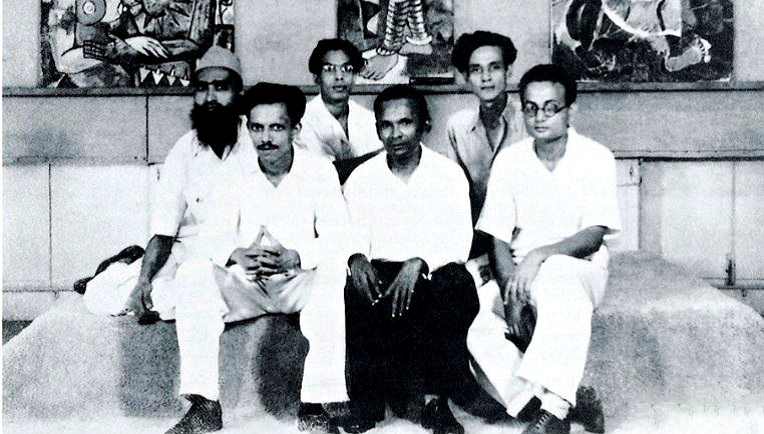The zeitgeist of a particular time period can be observed in its social and cultural history, its political and diplomatic atmosphere. The pre-independent time of late 30’s or the decades of the 40’s hence shaped its descendent decades. Many of us may have wished to forget the brutal impact of World War II, the man-made Bengal Famine of 1943, the struggle for Independence and equal ruthlessness unleashed by the British colonial administration or even the holocaust of the Hindu-Muslim riots before and after Partition. But living and breathing in those troubled times were not easy for sensitive souls like the poets, authors or the artists. The instability and seething anger in the society make most of the artists to raise their voice. However, raising voice doesn’t necessarily mean a direct approach of theirs angst. The Nationalistic movement in the fields of visual arts that lead by the Bengal school artists like Abanindranath Tagore, as a matter of fact, was more a passive kind of reaction or answer to the British authority. Although there were men having radical thoughts in mind could not be soothed by the approach of Bengal school. These radical minds wanted to reach higher grounds taking the theoretical and critical knowledge from the Western world, they tried to make an impact on the viewers and lovers of visual art with an approach of a modern outlook towards life.
There is no precise definition of the term “Modern Art”, however Modernism in the fields of Visual Arts can be defined as a radical break with the past and the concurrent search for new forms of expression in favor of newer artistic experiments with the visual language.
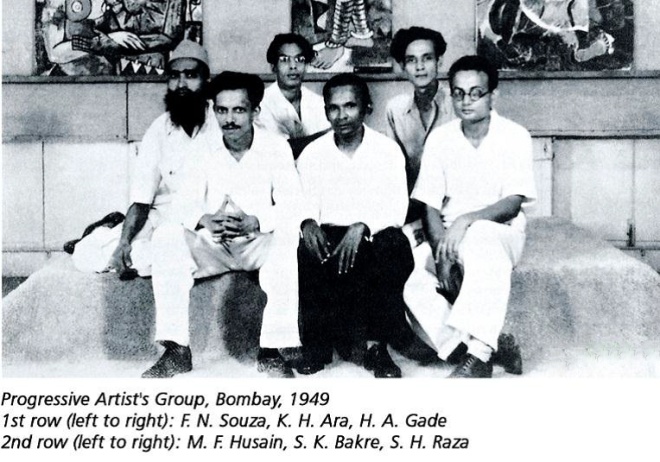
The Decades of 40’s witnessed the rise of artists like Somnath Hore, Chitttoprashad in Kolkata; forged from a suppressed angst and misery their radical minds rose against the British imperialistic rule. The same kind of approach was seen in the heart of the nation, Delhi- The setting up of Delhi Silpi Chakra with the artists like Sailoz Mukherjee, B.C. Sanyal, Dhanraj Bhagat, Dinkar Kowshik, and K.S. Kulkarni and followed by Satish Gujral during the year of 1947. In the same year, in the month of December another group formed with such radical minds like F.N Souza, K.H Ara, Sadanand Bakre and S.H Raza and finally followed by M.F Husain and H.A Gade, in Mumbai. The group was called The “Progressive Artists Group”. The title ‘Progressive’ was influenced by the Progressive Writers’ Movement which was started in Indian literature by the Marxist novelists, poets, and authors at a conference held in 1936. The Progressive Artists Group aka ‘PAG’ had an anti-Imperialist outlook and tried to bridge the space between the artists and the life of the general people- it was stated in their short manifesto.
One of the oldest members of PAG. Francis Newton Souza was born in Goa in 1924 to a Roman Catholic family but life was not very easy for as he lost his father when he was only three months old. Joining Sir J. J. School of Art in 1940 was a major turning point as he mastered the academic naturalistic style of painting. But joining the communist party at the later period, influenced him for shaping his rational Marxist ideas- that can be seen in one of his earliest painting called ‘The Goan Peasants’.
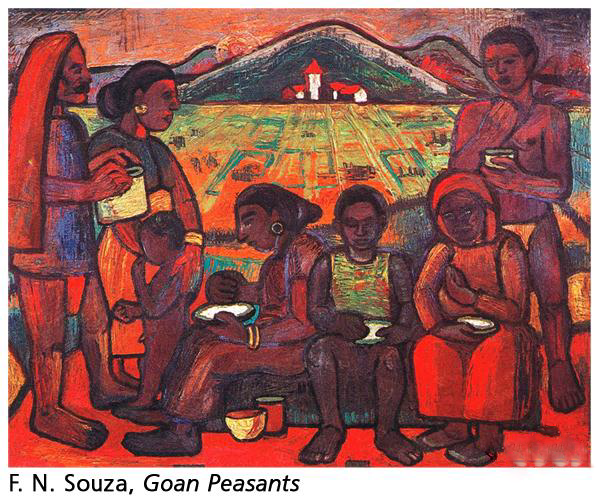
The bold and broad broken dabs of rich warm colour tinted the whole image. Using the warm vermillion on the foreground and on the figures somehow suggest the inclination towards the Marxist ideology. The distant church too draped in the strong hue of Vermillion. The peasants are having their meals, their strong muscular built bodies are defined by the bold black contours of the body. The influence of the famous Mexican Muralist Diego Rivera is quite evident in the overall approach towards the figuration and the bold strokes. The ethos and the pathos of the peasants are realistically rendered. However, it’s the reality in the painting, the rawness of the colours that weren’t seen in the contemporary time of early 50’s. Its radical approach towards the visual language that marked the rise of a painter with whom we can certainly relate the word ‘Modern’.
Before the major PAG exhibition (1949) Souza had held his one-man show named as the ‘Farewell Show’. The show includes various other nude imageries inspired after the Khajuraho sculptures. It was here that Souza had exhibited his fully naked Self Portrait which had aroused quite a controversy. The realistic representation of the frontal nudity of the artist himself shocked its viewers. Holding a long flat brush in his left hand the artists gazes to the viewers directly. The known patches of colours are there. The arms are distorted in proportion, quite big and bold for the rest of the body. The checkered floor and a small open window behind the artist, however, did not match in terms of perspective. It’s not the naturalism but it’s all about the fragmented realities around the artist that get conveyed in the painting as he himself felt. In the later period, Souza tried to incorporate the coloristic developments made familiar by the newly discovered both German Expressionist use of color and as well as the Fauvist use of color as we can see in the works of Matisse.
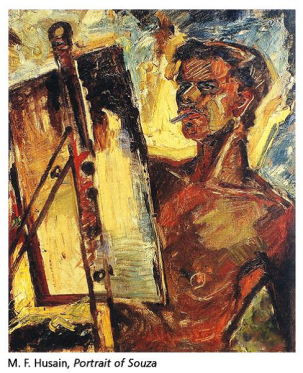
One of the earliest paintings of Husain as a member of PAG was the portrait of Souza done in 1950. The Bare-bodied Souza, cigarette in his mouth, intensely engrossed in painting the canvas; represented by the animated bold contours and accentuate colour that can be associated with the Expressionistic approach in Europe particularly similar in manner to the painter Kokoschka. The use of burnt sienna and burnt umber in rendering Souza’s bare muscular chest and the use of shades of yellow in the background and it the parts of the canvas was quite revolting, keeping in mind the nationalistic approach that many of the artists of the nation took, including the Bengal School. However, the sheer swiftness of the brushwork achieved to get a sense of animation in the painting. As a matter of fact, Husain developed an individual style in the later works which can be described by the sheer simplicity and monumentality of image, achieved through bold lines, bright resonating colour, and heavy brushwork.
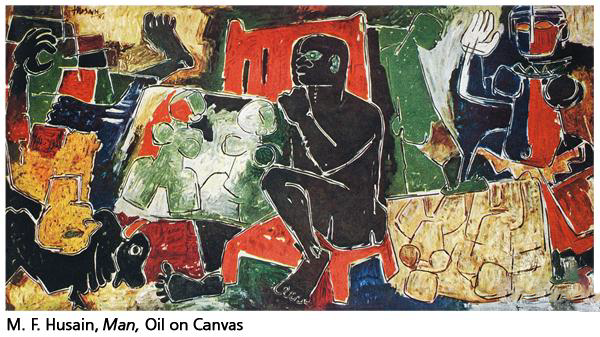
The emancipation of colour, one of the various aspects of Fauvists; that somehow inspired Husain, can be seen in his earlier works like the above one. The bold lines and the rich heavy colour gives the painting a sense of monumentality. The lines are so bold that it dominates the whole image, however, creating right balance with the applied heavy colours. The figures are linear in quality, however, a close derivative of folk prototypes that also has the robustness of Indian traditional sculptures. In some portions the outline of the figures extended to planes and merged with other colour, and in some parts, the contours of figurative forms merged with the background colour creating tension between forms and figures.
S.H. Raza was much different in temperament that Souza or Husain had. Studied the Academic approach of painting from Nagpur school of Art, Raza predominantly was inclined towards landscape paintings. Trained in the genre of opaque color popularized by Bendre and Solegaonkar, he also mastered the traditional watercolour landscape paintings with panoramic views but soon evolved a different visual language to narrate his landscapes.
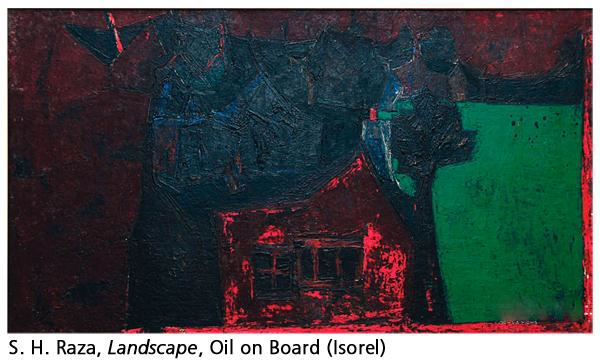
Raza intently discards the old school traditional naturalistic approach towards landscape paintings and evolve his own language that predominant by the ideas of opaque colours that he influenced by the school of Bendre and Solegaonkar. His landscapes thus do not depict any recognizable natural scene but the use of heavy patches of opaque colours celebrates the Nature’s playfulness with colours thus giving his paintings a universal identity. It is quite obvious such radical mind would come into the folds of PAG where the members can share their ideas with others.
Among the other members of PAG, H.A. Gade was sounder in terms of academic background. Earning degrees in science and education from Nagpur University, he completed his initial training in painting from Nagpur and soon completed diploma from Sir J.J School of Arts, Mumbai. Stylistically he was more inclined towards the colour treatment of Raza, however, Gade’s paintings consist more rich and warm colour applied into the simplified form of childlike figures that contoured by bold lines. Gade also experimented with various other directions. He soon joined PAG as persuaded by Raza.
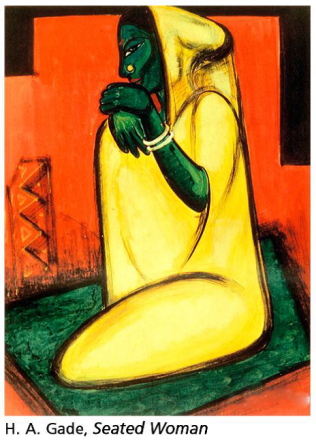
The artists of PAG displayed a willingness, a desire to look towards European modernism to find means to break away from the fruitless pursuit of naturalism or revivalism. And thus almost all of them, at least in the first few years of PAG, went back to the roots of Indian identity, classical traditions of art, the faces and the bodies of the inhabitants of this diverse land, their art, lifestyle and more. On the other hand, the so-called ‘primitivist’ mode of Western modern art also influenced these artists to seek the essence of their own identity in the rich folk culture of their native land.
As a matter of fact, The J.J School of Art (established 1857), formed a major institutional context for the art fraternity in Bombay. A long-standing bastion of conservative values in art education following neo-classical Victorian modes. But soon it began to face changes in the form of the inclusion of training in ‘Indian style’ and mural painting during the tenure of Gladstone Solomon as Director (1919-37). This institution played an important pedagogic role, however, it also gave a structure to these artists like Souza to protest and rebel against. And of course, Husain followed him in joining and forming PAG. The 1940s was a momentous decade. A progression of events and circumstances led to the birth of an independent nation: the Quit India movement of 1942, the Bengal famine of 1943, the breakdown of talks between Gandhi and Jinnah and the subsequent trauma of the partition of India that came hand-in-hand with the euphoria of liberation. In the year 1944 that Jawaharlal Nehru wrote his Discovery of India in Ahmednagar Fort Prison, B. R. Ambedkar was working on What Gandhi and the Congress have Done to the Untouchables. 1946 and 1947 saw Communist-led peasant uprisings in Tebhaga and Telangana respectively. The adoption of the Constitution in 1950 which abolished separate electorates and envisaged protection to weaker sections of society was preceded in 1949 by the formation of the Jharkhand Party.
In the fields of culture a socialist inclination was visible from the establishment of the Progressive Writers Association (1936) and the Indian Peoples’ Theatre Association (1944), as well as from groups of visual artists who described themselves as “progressive”—the Calcutta Group (1942), Progressive Painters Association, Madras (1944) and of course, the PAG, Bombay, in the year of independence.
It is in this situation that the group of six young men from Bombay who called themselves the PAG sought to make their intervention in terms of a radical bid for a universalized modem sensibility It is significant that of the six members of the Group, three, Souza, Husain and, were from minority backgrounds, a fourth, Ara, had Dalit antecedents.; Their social and economic backgrounds lend a special gravity to their bid for this universalized modernism in the context of the newly-independent India.
When the group first held its exhibition in then Bombay in 1948. The writings on the pamphlet catalog of the group show penned by Souza is important to look to further understand their outlook towards ‘ART’ more effectively. Souza wrote, ” I do not understand now, why we still call our Group ‘Progressive’….we have changed all the chauvinist ideas and leftist fanaticism which we had incorporated in our manifesto at the inception of the group: To bring about a closer understanding and contact between different sections of artists’ community and the people…we found this in the course of working an impossibility, because there is not only a permanent rift between sections of artists,…. but the gulf between the so-called ‘people’ and the artist cannot be bridged.”
The change in the attitude can possibly be understood as the inner turmoil that the members of PAG had face along with various others artists of that time. The world at large had seen the shifts of Realism to Cubism and Expressionism in the field of Visual Art in Europe. The urge to catch up with the international mode of representation was too influential for the artist of India; however, there is another turmoil of creating one national identity at large which too had a great impact on the artists. Most of the members of PAG was somehow influenced by the Cubist or Expressionist phenomenon which can be justified by the above reasons. The rise of this newly shaped ideas created what we call ‘Modern’ in terms of a whole new approach to representation. Thus they had to reject the past and hold the newly shaped ideologies as old traditional aspects of painting would not justice their ‘freedom of expression.’ As a matter of fact, the stylistic features of Post-Impressionism, Synthetic Cubism and Expressionism made the most profound impact on the artists of PAG and eventually they harnessed these various international theories with national and traditional aspects of Visual language creating one ‘Indian Modernism’- a whole new approach to look at ART which essentially had a nationalistic rendition in terms of stylistic features as well as various subjective exposure.
- REFERENCE
Chaitanya Sambrani. (2003). The Progressive Artists’ Group. In G. Sinha, Indian Art: An Overview. Rupa & Co.
Gayatri Sinha. (2009). Art and Visual Culture in India. Marg Publications.
Yashodhara Dalmia. (2001). the Making of Modern Indian Art the Progressives. New Delhi.
Ratan Parimo & Nalini Bhagwat. PAG: An Overview
*The Images are taken from open Web sources.
